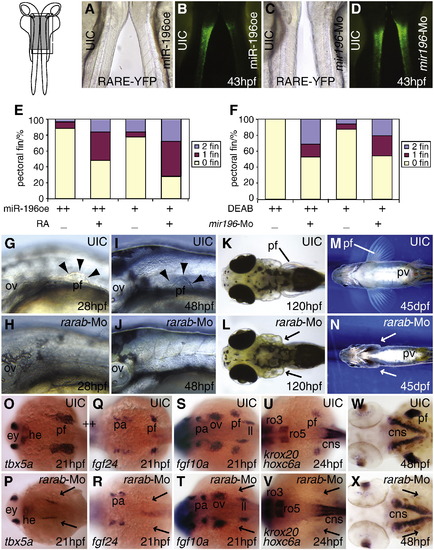
miR-196 activity modulates RA signaling. (A) Bright field microscopy of a 43 hpf uninjected control transgenic RA signaling reporter individual and a miR-196 injected 43 hpf RA-reporter embryo oriented back-to-back as in the insert at the left of part (A), with the boxed region blown up in A–D. (B) The animals in (A) was viewed in fluorescence microscopy. The intensity of green fluorescence is proportional to the level of RA signaling, and was greatly reduced after miR-196 overexpression. (C) Bright field and (D) fluorescence views of a control (left) and a miR-196-morpholino injected 43 hpf embryo (right). The elevated expression of YFP found after miR-196 knockdown is opposite to the phenotype found after miR-196 overexpression. (E, F) Rescue experiments. (E) Although injecting cleavage embryos with 5 nL of miR-196 duplex and treating them with DMSO as controls (++) caused a greater fraction of animals to develop without pectoral fins (89%, n = 63) than injections with 1 nL (+) (78%, n = 76), both can be rescued by RA treatment (+) (48%, n = 81 and 28% n = 61 without fin respectively). This experiment was repeated four times. (F) Treating embryos with 1 × 10-5 M (++) or 5 × 10-6 M (+) DEAB to decrease RA levels resulted in all (100%, n = 31) or most of the animals (87.5%, n = 16) lacking pectoral fins respectively, but first injecting cleavage embryos with 1 nL of 3 mM mir196-Mo (+) to diminish the inhibition of RA signaling before treating embryos with DEAB, led to partial rescue of the fin phenotype (just 53%, n = 51 or 54%, n = 48, respectively). Compared to controls (G, I, K, M), rarab-Mo injection (H, J, L, N) inhibited pectoral fin outgrowth already by 28 hpf (G, H) and this phenotype was maintained through 48 hpf (I, J), 120 hpf (K, L), and into adulthood (M, N) verifying the specificity of the effect. Arrowheads mark the edge of the pectoral fin and arrows direct attention to missing pectoral fins and buds. (O–V) rarab-Mo inhibited expression of the pectoral fin genes tbx5a (O, P), fgf24 (Q, R), fgf10a (S, T), and hoxc6a (U, V), as well as the fin muscle marker gene lbx1b (W, X) specifically in the fin field region while leaving other expression domains intact, the same result as from miR-196 injection. Arrows: missing pectoral fin buds. cns, central neural system; ey, eye; he, heart; im, intermediate mesoderm; ll, lateral line primordium; ov, otic vesicle; pa, pharyngeal arch; pf, pectoral fin; pv, pelvic fin; ro3, -5, rhombomere3, -5.
|

